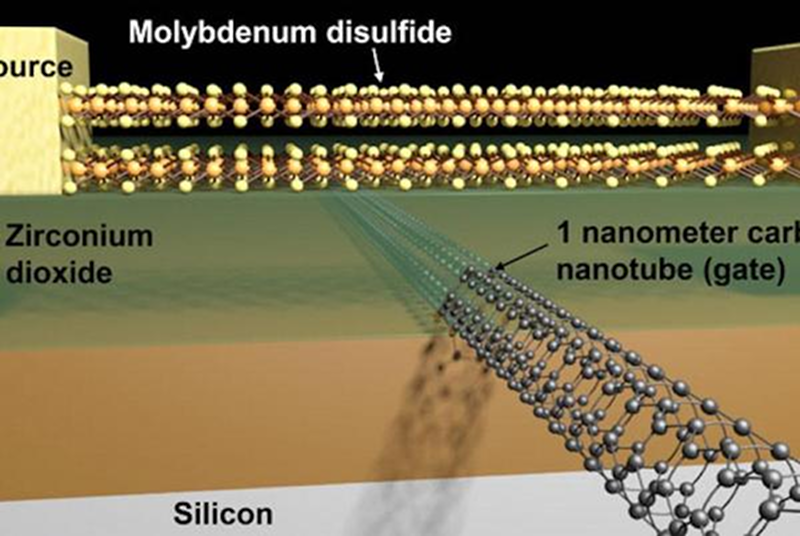Silicon transistors keep shrinking (current state of the art is about 20 nanometers). However–in theory–once the gate goes to 5 nanometers, the electrons tunnel through the channel making it impossible to turn the transistor off. Berkeley researchers have used a different material to produce a transistor with a 1-nanometer gate. For point of reference, a human hair is about 50,000 nanometers thick.
The secret is to switch away from silicon in favor of another semiconductor. The team’s choice? Molybdenum disulfide. Never heard of it? You can buy it at any auto parts store since it is a common lubricant. Electrons have more effective mass as they travel through molybdenum disulfide than silicon. For a larger transistor, that’s not a good thing, but for a small transistor, it prevents the electron tunneling problem.
Creating a 1-nanometer structure is a challenge all by itself. The new transistor uses a 1-nanometer carbon nanotube as the gate. The transistors will need work to be commercially producible.
We didn’t know that a common lubricant is a semiconductor with similar properties to silicon. We looked at its use in thin semiconductors with graphene. We even talked about its use as a lubricant before. We just didn’t put two and two together. That’s the kind of thing that gives us ideas.
















Ideas, what me? Axle grease solar panel now? Don’t be ridiculous…. wait…. how do we do that?
ITO or graphene on yer glass? Graphene by nickel process… moly, how do we dope it?
Actually is it sufficiently graphite like that you can get it to form a structure analogous to graphene?
Okay we’re getting warm with the graphene structure…www.nature.com/nnano/journal/v7/n11/full/nnano.2012.193.html and…www.nature.com/nnano/journal/v8/n7/full/nnano.2013.100.html
Comon Man! Don’t start using buzzfeed-esque headlines, your above this!
What’s not fun about about this title? To me it feels like headlines we’ve used since the beginning. There’s nothing sensational about it… legitimately they made transistors smaller that was though possible/practical.
Buzzfeed-esque would be: “Five Shocking Tricks Scientists Used to Shrink Your Microchips”
I like the title and agreed Hackaday has always used similar pun like titles.
Wait until the mailman breaks some displays he orders by tossing them over the fence, then we’ll have one like Szczys Sick as Sixty Pixies over Nixies Frisbee…
Maybe he prowls the Register daily and C&Ps the good ones…
so, this is my contact lens as a computer.
But you’ll never see straight again, it will keep slipping LOL.
Well, if you read the paper you´d realise that only the carbon nanotubes are 1nm thick. The whole transistor is bigger (even than traditional designs). Its still a good experiment and a good paper with a lot of potential, but no 1nm transistor.
It is the channel width not the entire transistor.
Moore’s Law lives!
It is 3.9 nanometer they made it 1 nanometer smaller than it was said it is possible. The whole thing is about 20 000 nanometer long.
Current state of the art is 16nm, not 20nm, even for commercial designs. 10nm has been in the works for a bit.
It’s a good time to be starting a Ph.D. in device physics!
certainly NOT, I’m in the business for 30 years. you’ll be unemployed, for sure.
Lots of bad info in here, currently Intel has sold 14nm for over a year now and IBM already has functional 7nm silicon.
http://arstechnica.com/gadgets/2015/07/ibm-unveils-industrys-first-7nm-chip-moving-beyond-silicon/
That was 2015.
If there is a hint of something exotic – hysterical hype ensues.
Well, manufacturing will be a severe problem – can’t be done with standard semi equipment, as RIE etching etc. Perhaps you’ll have to print or use precursor and Ion beam technologies. Don’t see this as a product, soon.
The problem with any mass produced transistor is replication- even if this works its going to need serious effort to guarantee that all the components work. One idea I did have is to replicate each component twice, but this just adds even more expense.
Why are we discussing physics when there are creepy clown sightings to worry about. Priorities, people!